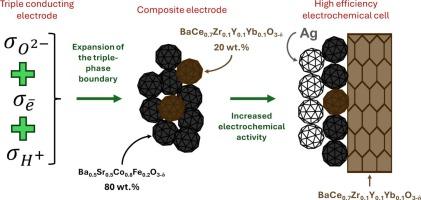Ba0.5Sr0.5Co0.8Fe0.2O3-δ- bace0.7 zr0.1 y0.1 yb0.1 o3 -δ复合电极的优化:组分比和集流器的影响
IF 3.3
4区 材料科学
Q3 CHEMISTRY, PHYSICAL
引用次数: 0
摘要
研究了复合电极Ba0.5Sr0.5Co0.8Fe0.2O3-δ- bace0.7 zr0.1 y0.1 yb0.1 o3 -δ在质子导电电解质电化学器件中的应用前景。采用阻抗谱法研究了不同组分比例的电极在含氧气氛中,用H2O和D2O加湿后的电化学活性。电极中各组分的最佳配比为80/20 wt% Ba0.5Sr0.5Co0.8Fe0.2O3-δ/BaCe0.7Zr0.1Y0.1Yb0.1O3-δ。这种组合物的电极在650℃的水湿空气环境中极化电阻为0.8欧姆*cm2。在相同条件下,使用集流器可以将极化电阻降低到0.5欧姆*平方厘米。对于所有研究的成分和条件,H/D同位素效应在电极响应中被检测到。讨论了电极组分与集流器配比对电极反应机理的影响。本文章由计算机程序翻译,如有差异,请以英文原文为准。

Optimization of Ba0.5Sr0.5Co0.8Fe0.2O3-δ-BaCe0.7Zr0.1Y0.1Yb0.1O3-δ composite electrodes: Influence of component ratio and current collector
Composite Ba0.5Sr0.5Co0.8Fe0.2O3-δ-BaCe0.7Zr0.1Y0.1Yb0.1O3-δ electrodes were studied as promising cathodes for application in electrochemical devices based on a proton-conducting electrolyte. Electrochemical activity of electrodes with different ratio of components was investigated by impedance spectroscopy in the oxygen-containing atmospheres, humidified with H2O and D2O. The optimal ratio of components in the electrode was found to be 80/20 wt% Ba0.5Sr0.5Co0.8Fe0.2O3-δ/BaCe0.7Zr0.1Y0.1Yb0.1O3-δ. The polarization resistance of the electrode of such a composition is 0.8 Ohm*cm2 at 650 °C in a H2O-humidified air atmosphere. The use of a current collector made it possible to reduce the polarization resistance to 0.5 Ohm*cm2 under the same conditions. For all investigated compositions and conditions, the H/D isotope effect in the electrode response was detected. The influence of the ratio of the electrode components and the current collector on the mechanism of the electrode reaction is discussed.
求助全文
通过发布文献求助,成功后即可免费获取论文全文。
去求助
来源期刊

Solid State Ionics
物理-物理:凝聚态物理
CiteScore
6.10
自引率
3.10%
发文量
152
审稿时长
58 days
期刊介绍:
This interdisciplinary journal is devoted to the physics, chemistry and materials science of diffusion, mass transport, and reactivity of solids. The major part of each issue is devoted to articles on:
(i) physics and chemistry of defects in solids;
(ii) reactions in and on solids, e.g. intercalation, corrosion, oxidation, sintering;
(iii) ion transport measurements, mechanisms and theory;
(iv) solid state electrochemistry;
(v) ionically-electronically mixed conducting solids.
Related technological applications are also included, provided their characteristics are interpreted in terms of the basic solid state properties.
Review papers and relevant symposium proceedings are welcome.
 求助内容:
求助内容: 应助结果提醒方式:
应助结果提醒方式:


